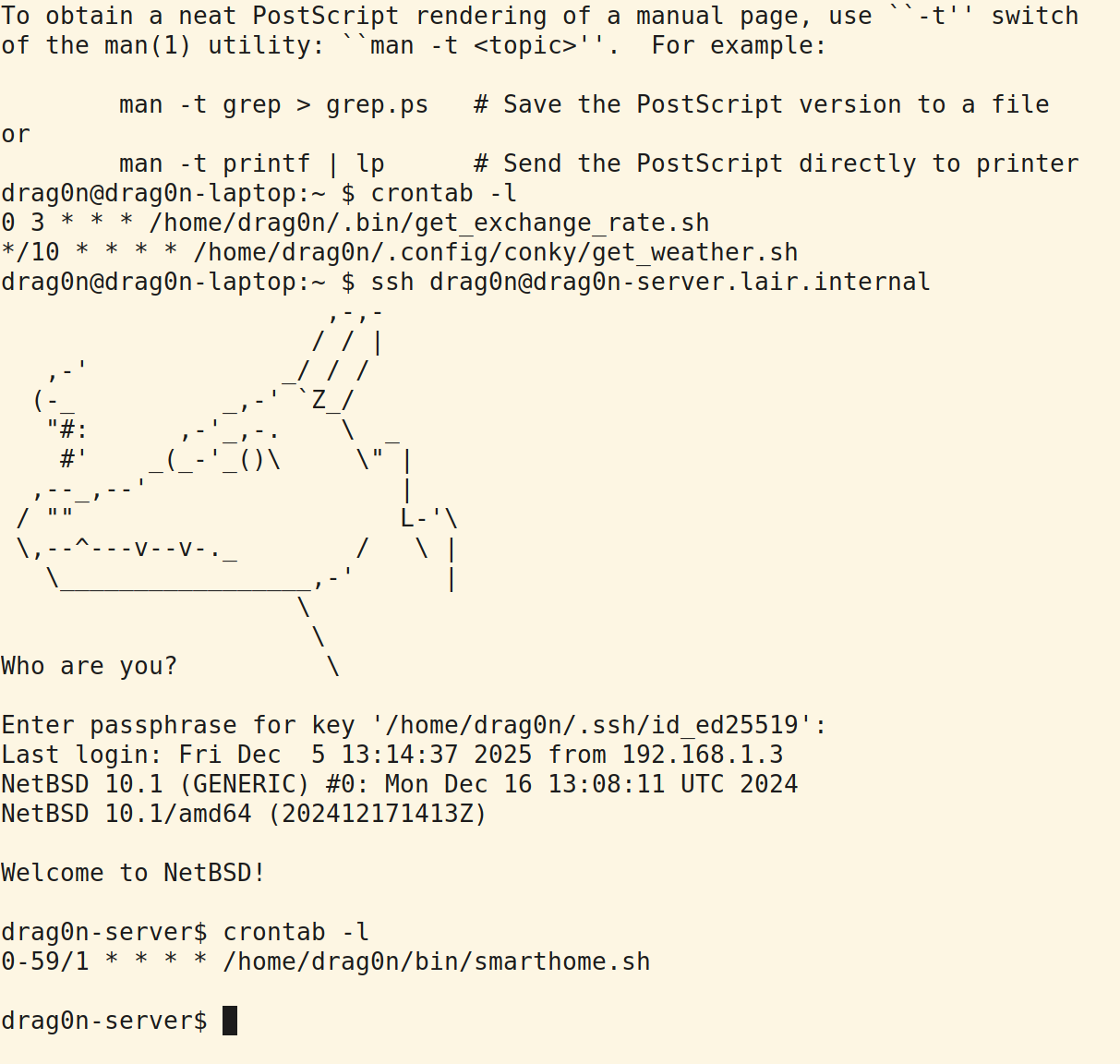Search results for tag #freebsd
Here is a small tip: to easily configure your installed FreeBSD, use the `bsdconfig` command as the root user. A lot of FreeBSD users or developers (including some IT/sysadmin folks) don't know this, but you can use `bsdconfig` to set up many system configuration settings, both for new systems and for changing settings on existing systems.
"Gotta try 'em all!" XD
I've spent some quality time in #OpenBSD and now #FreeBSD, I'd like to try #NetBSD and #DragonflyBSD next.
(This is regarding https://mastodon.bsd.cafe/users/gumnos/statuses/115695846629134863. Not sure why the context got lost XD)
 boosted
boostedWell, fuck. As the apes at the end of the Spaceballs movie would say, there goes the planet. 
 boosted
boostedI understand the strain on maintainers, but it's still sad to see #FreeBSD culling so many 32bit packages. #OpenBSD suffers from the same problem. It seems #NetBSD will remain the platform where you can still e.g. get a working web browser for a legacy system (#Arcticfox). Same applies to the Linux world.
 boosted
boostedBSDCan 2026 is now accepting submissions for the June 2026 conference, see https://www.bsdcan.org/2026/papers.html and links therein for instructions.
Submissions deadline is January 17, 2026, the conference runs tutorials June 17-18, talks June 19-20.
#bsdcan #conference #freebsd #netbsd #openbsd #bsd #development #networking #freesoftware #libresoftware
In order to enable audio support in a jailed #xrdp desktop, install pulseaudio-module-xrdp package. Viola! Works like a charm with MS Windows RDP app.
 boosted
boostedApparently users are ignoring the dire warning from freebsd-update to update ports first before finishing the upgrade to 15.0
*sigh*
 boosted
boosted#FreeBSD 15.0-RELEASE has landed!
https://www.freebsd.org/releases/15.0R/announce/
I’m proud of so many things in this release, but one most of all :-
The collaboration and contributions for hundreds of people from so many countries and continents around the world.
We may not agree about pineapple on pizza, but we’re all part of building a terrific community-lead freely-licensed open source OS, used in everything from massive storage appliances and internet-scale routers, down to gaming consoles, and embedded systems.
Thank-you everybody!
I run FreeBSD but I don't tend to build it. I consume binaries. So sometimes I make assumptions based on its similarities to NetBSD, which was the first free Unix I ran.
Today I read that FreeBSD finally does unprivileged builds, to which I thought, "What? It didn't before?"
https://freebsdfoundation.org/blog/freebsd-now-builds-reproducibly-and-without-root-privilege/
Meanwhile, NetBSD has been incredibly sleek in this department for many years now:
https://www.netbsd.org/docs/guide/en/chap-build.html
I should get back into NetBSD. I was initially enthralled by VNET jails but lately I find myself using simpler configs. I might find that I'm okay going back to running things in chroots. And it's not like I'd stop running FreeBSD.
 boosted
boosted@uastronomer Possibly I disappoint you, but looks like the same situation with almost every binary package distribution. For example, if I try to install #Qemu to the **headless** server running #NetBSD , just to run some other OSes in the console mode, the dependencies bring to me:
- SDL2 and SDL2_image
- flac, giflib, lame, libjpeg-turbo, libogg, libopus, libvorbis, libwebp, mpg123, tiff — like I'm want to operate with images and audio files, not to launch some virtual machines
- spice-server, while I'm not planning to use it.
- wayland and wayland-protocols -- no comments 
As @TomAoki stated one time on my ramblings about the same situation in the #FreeBSD world: "many of opensource audio and/or multimedia apps are developed on any of Linux distros, not on *BSD, thus, to minimize mandated works of porters / maintainers / commiters, depending on what upstream depends by default is the only feasible way not to cause toooo long delay from upstream".
I lost link to his toot on the old account, but I have a screenshot: https://eugene-andrienko.com/assets/static/tomaoki.png
One way to get rid of unnecessary dependencies — build necessary programs by yourself, looks like…
Does anyone manage to use the #keyboard media controls in #FreeBSD #Xorg? I have a DasKeyboard with a volume jog that works out of the box on #OpenBSD.
The events seems to be working using xev tester. It regognizes the RaiseVolume and LowerVolume events.
Not sure where to actually start looking for a solution.
"The contrast with Docker is striking: while the Docker container required 100% CPU to reach peak for the HTTP and HTTPS throughput, the FreeBSD jail delivered the same speed with ~60% of the CPU sitting idle. In terms of performance cost per request, Jails are drastically cheaper."
#ITNotes #Linux #Docker #Containers #FreeBSD #RunBSD #IT #SysAdmin
RE: https://mastodon.social/@nixCraft/115566280074527897
"Just" 270 MB for...an idle server?
Debian is still a great distribution but let's measure the ram consumption of a freshly installed *BSD or Illumos based server. The numbers are totally different.
Last week I had a chat with a colleague who is highly specialized in Microsoft solutions. Young but not too young, smart, not very up to date simply because he has little time for anything else. His specialization depends entirely on where he works, not on personal interest. Lately he seemed a bit disillusioned with some choices made by "other operating systems", and he was starting to consider moving his personal projects toward Microsoft as well, since he already had the experience. Still, he said it with boredom. With the attitude of someone who is tired of wasting time.
He had heard of the BSDs but had never tried installing them. He was convinced that there were no decent hypervisors outside the Linux world and that KVM belonged to Linux alone. I had the terrible idea of showing him the BSDs, how great bhyve is, and how nvmm on NetBSD uses qemu underneath, making it almost a replacement for KVM in many setups. He lit up with the look of someone waking up from a long sleep. I also had the terrible idea of showing him illumos and its distributions. He had no clue it existed and thought old, great Solaris had been dead for years thanks to Oracle.
He called me a little while ago. He was furious. He spent the whole weekend doing tests and now he has no idea what to use among FreeBSD with bhyve, NetBSD with nvmm, and illumos with bhyve or kvm. He is slowly starting to explore jails and illumos zones. He was annoyed (in a positive way) because now he does not know what to pick since everything feels so different from what he was used to, and he found advantages in each option.
I am obviously happy about it, but I also wonder: instead of reinventing the wheel every time, would it not sometimes be better to simply broaden our horizons?
#IT #SysAdmin #OperatingSystems #FreeBSD #Linux #NetBSD #OpenBSD #DragonflyBSD #illumos #SmartOS #OmniOS #OpenIndiana #Tribblix
RE: https://mastodon.bsd.cafe/@gumnos/115551343732704834
This is a great post.
It's not "against" something - it just explains why Tim prefers to use the BSDs.
 😎
😎 

![[?]](https://snac.bsd.cafe/rl_dane/s/fa209ad9e80a95b8ce58002167cdda59.png)



![[?]](https://pleroma.anduin.net/media/e42775318fd38a77b2c02300192e27e61861443424849feef9767918512fac8b.png?name=blob.png)


![drag0n-server# pkgin install qemu
pkg_summary.bz2 100% 3935KB 67.8KB/s 00:58
calculating dependencies...done.
36 packages to install:
SDL2-2.32.10 SDL2_image-2.6.3nb6 capstone-5.0.6 dtc-1.7.2 fftw-3.3.10nb2 flac-1.5.0nb1 giflib-5.2.2nb1 gmp-6.3.0 hicolor-icon-theme-0.17nb1
jbigkit-2.1nb1 lame-3.100nb7 lerc-4.0.0 libcbor-0.13.0 libepoll-shim-0.0.20240608 libgcrypt-1.11.2 libgpg-error-1.55 libiscsi-1.19.0
libjpeg-turbo-3.1.2 libogg-1.3.6 libopus-1.5.2 libsamplerate-0.2.2nb5 libslirp-4.7.0nb2 libsndfile-1.2.2nb2 libssh-0.111nb2 libtasn1-4.20.0
libusb1-1.0.29 libvorbis-1.3.7 libwebp-1.6.0nb1 libxkbcommon-1.7.0nb6 mpg123-1.33.2 qemu-10.1.0nb1 snappy-1.2.2 spice-server-0.15.2nb1
tiff-4.7.0nb3 wayland-1.23.0nb7 wayland-protocols-1.45
0 to remove, 0 to refresh, 0 to upgrade, 36 to install
107M to download, 898M of additional disk space will be used
nroceed ? [Y/n]
drag0n-server# pkgin install qemu
pkg_summary.bz2 100% 3935KB 67.8KB/s 00:58
calculating dependencies...done.
36 packages to install:
SDL2-2.32.10 SDL2_image-2.6.3nb6 capstone-5.0.6 dtc-1.7.2 fftw-3.3.10nb2 flac-1.5.0nb1 giflib-5.2.2nb1 gmp-6.3.0 hicolor-icon-theme-0.17nb1
jbigkit-2.1nb1 lame-3.100nb7 lerc-4.0.0 libcbor-0.13.0 libepoll-shim-0.0.20240608 libgcrypt-1.11.2 libgpg-error-1.55 libiscsi-1.19.0
libjpeg-turbo-3.1.2 libogg-1.3.6 libopus-1.5.2 libsamplerate-0.2.2nb5 libslirp-4.7.0nb2 libsndfile-1.2.2nb2 libssh-0.111nb2 libtasn1-4.20.0
libusb1-1.0.29 libvorbis-1.3.7 libwebp-1.6.0nb1 libxkbcommon-1.7.0nb6 mpg123-1.33.2 qemu-10.1.0nb1 snappy-1.2.2 spice-server-0.15.2nb1
tiff-4.7.0nb3 wayland-1.23.0nb7 wayland-protocols-1.45
0 to remove, 0 to refresh, 0 to upgrade, 36 to install
107M to download, 898M of additional disk space will be used
nroceed ? [Y/n]](https://media.bsd.cafe/bsdmmedia01/media_attachments/files/115/598/818/595/223/832/original/676009464f0456b8.png)

